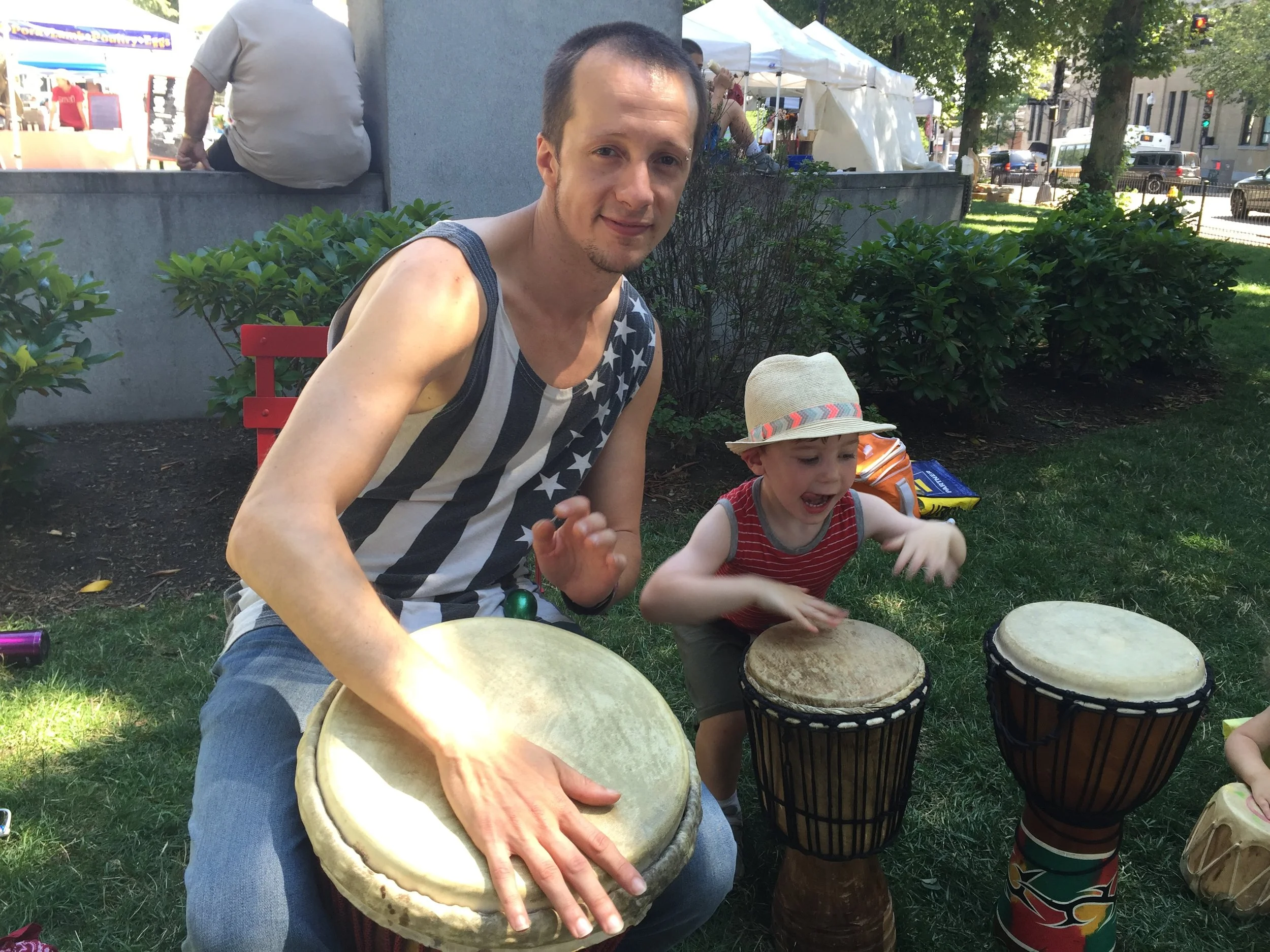Percussion
Drums are the oldest and most widely used instruments in human history. They’re also some of the most fun to play! Rhythm is the backbone of all music, and percussion has long been the foundation of musical cultures and traditions throughout the world. My background is primarily in West African percussion, which has a particularly long and storied history and continues to be a prominent cultural force today. Djembe drums are played in ensembles of four or more musicians arranged in a circle or semi-circle. The drummers are frequently accompanied by additional percussionists playing shakers, blocks, and bells. Drummers play a series of complimentary rhythms simultaneously that form a fantastically sophisticated groove. The music is designed for singing and dancing, and it shows; take a listen and you can’t help but move along with it.
Jonathan finds the beat!
Drumming and loving it at the farmer’s market.
Pros
Percussion requires no special technique to produce a pleasing sound, making it great for beginners! Many music classes for babies and toddlers use shakers, blocks, and small hand drums. I teach group drum classes to children as young as 2.5 years old, and it’s a blast. They’re so simple to use that a typical child can learn and play their first rhythm in less than a minute. Like the ukulele, the short learning curve and near-immediate gratification helps kids form a positive relationship with music from the get-go.
Studying percussion is invaluable in attaining basic rhythmic competency (the ability to hear, understand, and perform simple rhythms), a grasp of the beat and its importance in music, and a good sense of time (the ability to maintain a consistent tempo, or speed, without speeding up or slowing down). Believe it or not, many students of other instruments practice for years and develop some seriously advanced playing technique without a strong sense of rhythm and time. Spending some time with drums will give you a firm grasp of these fundamentals and a corresponding skill set that you can apply to any instrument you choose!
Drums are made to be played in groups. They’re ideal for classrooms, groups of friends and family members, and community ensembles.
Worried your child (or you, for that matter!) will break their instrument? There are a number of great manufacturers that make affordable drums from near-indestructible plastic materials.
cons
Most drums are amelodic, meaning they’re not used for melody. They may produce a certain pitch, but they don’t play notes and scales in the traditional sense, and are used for rhythm only.
Percussion can be fun to play by itself, but for most people it’s only really satisfying to play as part of a group, either a drum circle or a band. If you want to play music but prefer to play it solo, percussion might not be for you.
Traditional wooden hand drums can break fairly easily if you’re not careful with them. The wood can crack, or the skin can break, compromising the tone or rendering the instrument unplayable altogether. The skin is attached to the drum through an extremely complex series of knots, and if it breaks, you may have to pay a professional $100 or more to replace it. That said, if you’re willing to compromise on the authentic wooden hand drum look, you can buy a great-sounding mechanical djembe that’s much easier and cheaper to fix.
A mechanical djembe. I have several and love them!
Drumming with Zoe!
what to expect
Hand drums are affordable, accessible, and enormously fun to play. Kids and adults alike will find they’re up and running on their new instrument in no time, giving them that true blue “I’m a musician now!” sensation in no time.
They’re perfect for people who find other instruments intimidating, or feel like they may not have enough time to practice. Plenty of people say “I can’t play music.” No one ever says “I can’t hit things.” Well, good news; if you can hit things, you’re halfway there! A minimal investment of time and energy will be enough to play some simple rhythms, and even join a local percussion ensemble!
African drumming has actually become a rather huge phenomenon here in the United States. If you do want to join an ensemble and perform, chances are you can find a drum circle in your area that’s open to the public.
I’ve stressed the simplicity of drumming a lot here. While it’s true that percussion has the shortest initial learning curve of perhaps any instrument I teach, it’s by no means limited to basic music and techniques. Like any other great player, master hand percussionists are true virtuosos who play astonishingly sophisticated music and study and practice their craft for years. That’s the beauty of percussion; it can be as simple or complex as you want it to be!




